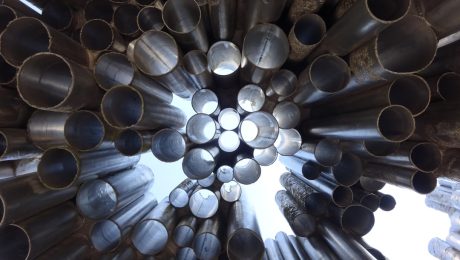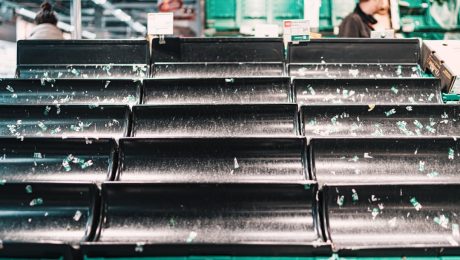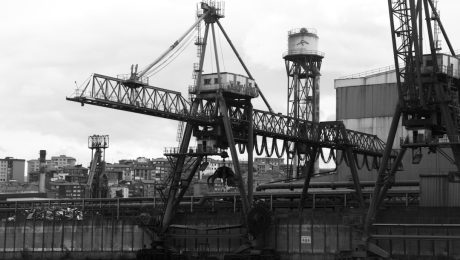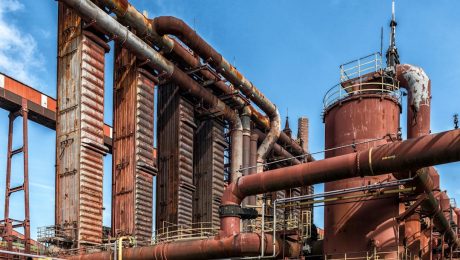Threaded pipes are a cornerstone of numerous industries, from residential plumbing to complex industrial systems. Their enduring popularity stems from a combination of robust features and significant advantages that surpass many alternative piping methods. This comprehensive guide delves into the intricacies of threaded pipes, exploring their key characteristics and highlighting why they remain a preferred choice for countless applications.
Superior Strength and Durability: The Foundation of Threaded Pipes
The inherent strength of threaded pipes is a primary reason for their widespread use. The threading process itself enhances the pipe’s structural integrity. The carefully cut threads create a mechanical interlock when the pipe is joined with a fitting, distributing stress evenly across the connection. This contrasts with some other joining methods that may concentrate stress points, leading to potential failure. The material of the pipe itself – often steel, galvanized steel, or other robust materials – further contributes to its exceptional durability. This makes threaded pipes highly resistant to pressure fluctuations, vibrations, and impacts, ensuring long-term reliability in demanding environments.
Leak-Proof Connections: Ensuring System Integrity
One of the most significant advantages of threaded pipes is their ability to create incredibly leak-proof connections. The tight mechanical grip provided by the threads prevents fluid leakage, even under high pressure. This is crucial in applications where leaks are unacceptable, such as transporting hazardous materials, handling potable water, or in high-pressure industrial systems. Properly installed threaded connections minimize the risk of leaks, reducing maintenance needs and enhancing overall system efficiency and safety. The use of sealant further enhances the leak-proof nature of the connection, creating a completely sealed and reliable joint.
Versatile Applications: Adaptability Across Industries
Threaded pipes find applications across a vast range of industries and projects. In residential construction, they are the backbone of plumbing systems, carrying water, gas, and drainage. Industrial settings utilize threaded pipes for steam lines, chemical processing, and oil and gas transportation. Their adaptability extends to various pipe materials, allowing for the selection of the optimal material based on the specific application’s requirements. This versatility, coupled with readily available fittings and tools, makes threaded pipes a practical and cost-effective solution for a wide spectrum of projects.
Ease of Installation and Maintenance: Simplifying Project Management
While specialized tools may be required for cutting and threading pipes, the overall installation process is relatively straightforward compared to some other piping systems. The simple, mechanical nature of threaded connections allows for quick and efficient assembly and disassembly. This ease of installation translates to reduced labor costs and faster project completion times. Maintenance is also simplified, as individual sections of the piping system can be easily accessed and replaced without disrupting the entire system. This is particularly advantageous in situations requiring frequent maintenance or repairs.
Cost-Effectiveness: Balancing Performance and Budget
Despite their superior strength and reliability, threaded pipes often represent a cost-effective piping solution. The relatively low cost of materials, coupled with the ease and speed of installation, can significantly reduce overall project expenses. The long lifespan and reduced maintenance requirements further contribute to the long-term cost-effectiveness of threaded pipe systems. While initial investment may vary based on pipe material and diameter, the overall return on investment is generally favorable, making threaded pipes a financially sound choice for a wide range of applications.
In conclusion, threaded pipes offer a compelling combination of strength, reliability, versatility, and cost-effectiveness. Their ability to create leak-proof connections, coupled with their ease of installation and maintenance, makes them a preferred choice across numerous industries. From residential plumbing to complex industrial systems, threaded pipes continue to demonstrate their enduring value and reliability as a fundamental component in diverse piping applications.
SEO-Friendly Tags:
- Threaded Pipe Installation
- Threaded Pipe Fittings
- Industrial Threaded Piping
- Benefits of Threaded Pipes
- Types of Threaded Pipe
Steel bridges, majestic symbols of engineering prowess, grace landscapes worldwide. Their design is a complex interplay of structural engineering, material science, and construction expertise. This comprehensive guide delves into the key aspects of designing these impressive structures, offering insights into the process from initial concept to final construction.
1. Understanding Load Calculations: The Foundation of Steel Bridge Design
Before a single steel beam is fabricated, a thorough understanding of the loads a bridge will endure is paramount. This involves considering various factors, including:
- Dead Loads: The weight of the bridge itself, including the deck, beams, columns, and other structural elements.
- Live Loads: The weight of vehicles, pedestrians, and other moving loads traversing the bridge. Design codes specify minimum live load requirements based on anticipated traffic volume and type.
- Environmental Loads: These include wind loads, snow loads, ice loads, and seismic loads. The geographical location significantly influences the magnitude and type of environmental loads considered.
- Impact Loads: Dynamic forces generated by moving vehicles, especially heavier ones, adding to the overall stress on the structure.
- Thermal Loads: Expansion and contraction of steel due to temperature fluctuations. Expansion joints and careful design are crucial to accommodate these changes.
Accurate load calculations are crucial for determining the required strength and size of the structural members, ensuring the bridge’s long-term stability and safety.
2. Material Selection: Choosing the Right Steel for the Job
Steel’s versatility makes it a preferred material for bridges, but the selection process is crucial. Various grades of steel exist, each with unique properties:
- Yield Strength: A measure of the stress at which the steel begins to deform permanently. Higher yield strength implies greater load-bearing capacity.
- Tensile Strength: The maximum stress the steel can withstand before breaking.
- Ductility: The ability of the steel to deform plastically before fracturing, offering some level of redundancy in case of overload.
- Weldability: Crucial for joining steel members. Certain steel grades are more easily welded than others.
- Corrosion Resistance: Factors like weathering steel (Corten steel) offer superior resistance to corrosion, minimizing maintenance requirements.
The choice of steel grade depends on factors like the bridge’s span, anticipated loads, environmental conditions, and cost considerations. Engineers carefully balance these factors to optimize the design.
3. Structural Analysis: Ensuring Bridge Stability and Strength
Sophisticated structural analysis techniques are employed to ensure the bridge’s stability and strength under various load combinations. These techniques include:
- Finite Element Analysis (FEA): A powerful computational method that divides the bridge into smaller elements, allowing for precise stress and deflection calculations.
- Linear and Non-Linear Analysis: Linear analysis assumes a proportional relationship between load and deformation, while non-linear analysis accounts for more complex material behavior.
- Dynamic Analysis: This considers the effects of dynamic loads, such as earthquakes and moving vehicles, on the bridge’s response.
- Stability Analysis: Evaluates the bridge’s resistance to buckling and other instability phenomena.
The results of structural analysis guide the design of the bridge’s various components, ensuring that they can withstand the anticipated loads without failure.
4. Fabrication and Construction: Bringing the Design to Life
The fabrication process involves cutting, shaping, and welding steel members according to the design specifications. Precise fabrication is critical to ensure the structural integrity of the bridge. Advanced techniques such as:
- CNC machining: Offers high precision and efficiency in cutting and shaping steel members.
- Automated welding systems: Ensure consistent weld quality and speed up the fabrication process.
- Quality control inspections: Rigorous inspections at each stage of fabrication are essential to identify and rectify any defects.
Construction involves transporting and assembling the fabricated components on-site. Careful planning and execution are crucial for efficient and safe construction, often involving specialized heavy lifting equipment and skilled crews.
5. Design Considerations for Sustainability and Aesthetics
Modern steel bridge design goes beyond mere structural functionality; it incorporates sustainability and aesthetics. This involves:
- Material Efficiency: Optimizing the design to minimize steel usage without compromising strength or safety.
- Lifecycle Assessment: Considering the environmental impact of the bridge throughout its entire lifecycle, from material extraction to demolition.
- Aesthetic Design: Integrating the bridge seamlessly into its surroundings while creating a visually appealing structure.
- Accessibility: Designing for pedestrian and cyclist access, enhancing the bridge’s usability and integration with the community.
By incorporating these considerations, engineers can create steel bridges that are not only structurally sound and efficient but also environmentally responsible and aesthetically pleasing.
Designing steel bridges is a complex and challenging endeavor, requiring a deep understanding of engineering principles, material science, and construction techniques. However, the resulting structures stand as testaments to human ingenuity and engineering excellence.
Tags: Steel Bridge Design, Bridge Engineering, Structural Engineering, Steel Construction, Civil Engineering
body {
font-family: sans-serif;
line-height: 1.6;
}
h1, h2, h3 {
color: #333;
}
img {
max-width: 100%;
height: auto;
}
Industrial pipes are the unsung heroes of manufacturing. These seemingly simple components are the lifeblood of countless processes, transporting vital fluids, gases, and slurries throughout factories and plants. Choosing the right industrial pipes is crucial for efficiency, safety, and the longevity of your operations. This comprehensive guide explores the key factors to consider when selecting and maintaining industrial piping systems.
1. Material Selection: The Foundation of Durability and Performance
The choice of pipe material is paramount and depends heavily on the substance being transported. Different materials offer varying levels of corrosion resistance, pressure tolerance, temperature resistance, and chemical compatibility. Here’s a breakdown of common materials:
- Carbon Steel: A cost-effective option for general-purpose applications, suitable for transporting water, steam, and many non-corrosive fluids. However, it’s susceptible to rust and requires protective coatings in corrosive environments.
- Stainless Steel: Offers superior corrosion resistance, making it ideal for handling aggressive chemicals, high-purity fluids, and food products. Different grades of stainless steel (e.g., 304, 316) provide varying levels of corrosion resistance.
- Plastic Pipes (PVC, CPVC, HDPE): Lightweight and corrosion-resistant, making them suitable for transporting chemicals and water in less demanding applications. Their temperature and pressure limitations should be carefully considered.
- Copper: Excellent corrosion resistance and thermal conductivity, making it suitable for potable water systems and applications requiring heat transfer. However, it’s more expensive than steel.
- Cast Iron: Durable and resistant to high pressure, but susceptible to corrosion and brittle failure. Often used in older infrastructure.
Selecting the appropriate material requires a thorough understanding of the fluid properties, operating conditions, and regulatory requirements.
2. Pipe Size and Diameter: Optimizing Flow and Efficiency
Determining the correct pipe diameter is crucial for efficient fluid transport. Undersized pipes lead to increased pressure drop, reduced flow rate, and energy waste. Oversized pipes are unnecessarily expensive and may not be practical for your space constraints. Factors influencing pipe size selection include:
- Flow Rate: The volume of fluid to be transported per unit time.
- Fluid Viscosity: The thickness of the fluid, affecting its flow characteristics.
- Pressure Drop: The loss of pressure as the fluid flows through the pipe.
- Pipe Length: Longer pipes result in higher pressure drop.
Hydraulic calculations are often employed to determine the optimal pipe size based on these factors. Software and online calculators can assist in these calculations.
3. Fittings and Connections: Ensuring Leak-Free and Reliable Systems
Proper connections are essential for a leak-free and reliable piping system. Various fittings are available to accommodate different pipe materials and applications:
- Threaded Fittings: Common for smaller diameter pipes, offering a relatively simple and cost-effective connection method.
- Flanged Fittings: Used for larger diameter pipes and high-pressure applications, providing a robust and easily maintainable connection.
- Welding: Provides a permanent and leak-proof connection for many materials, particularly steel and other metals.
- Compression Fittings: A relatively simple and quick connection method, often used for plastic pipes.
Choosing the right fitting type is crucial for ensuring system integrity and preventing leaks, which can lead to significant safety and environmental hazards.
4. Safety and Regulatory Compliance: Meeting Industry Standards
Safety is paramount in industrial settings. Compliance with relevant safety regulations and industry standards is crucial. This includes:
- Pressure Testing: Ensuring pipes can withstand the operating pressure without failure.
- Material Certifications: Verifying that the pipe materials meet the required specifications.
- Regular Inspections: Identifying potential problems before they lead to leaks or failures.
- Proper Installation: Following industry best practices to ensure a secure and leak-free installation.
- Emergency Shutdown Procedures: Having clear procedures in place to handle leaks or other emergencies.
Failure to comply with safety regulations can lead to serious consequences, including injury, environmental damage, and significant financial losses.
5. Maintenance and Inspection: Extending the Lifespan of Your Piping System
Regular maintenance and inspection are essential for extending the lifespan of your industrial piping system. This involves:
- Visual Inspections: Checking for corrosion, leaks, and damage.
- Pressure Testing: Regularly testing the system to ensure it can withstand the operating pressure.
- Cleaning: Removing buildup and debris that can restrict flow and damage the pipes.
- Repair or Replacement: Addressing any identified problems promptly to prevent larger issues.
- Record Keeping: Maintaining detailed records of inspections, repairs, and maintenance activities.
A proactive maintenance program can significantly reduce the risk of failures and costly downtime.
By carefully considering these factors, manufacturers can select and maintain industrial piping systems that are efficient, safe, and compliant with industry standards. The right pipes are not just a component; they are the foundation of a successful and productive operation.
Tags: Industrial Pipes, Manufacturing Pipes, Pipe Materials, Piping Systems, Industrial Piping
The steel industry, a cornerstone of global infrastructure and manufacturing, faces a monumental challenge: achieving net-zero greenhouse gas emissions. This blog post delves into the complexities of this transition, exploring the hurdles, innovative solutions, and the crucial role of collaboration in forging a greener future for steel production.
The Carbon Footprint of Steel: Understanding the Challenge
Steel production is notoriously carbon-intensive. The traditional blast furnace-basic oxygen furnace (BF-BOF) route, the most prevalent method globally, relies heavily on coking coal, a fossil fuel responsible for significant CO2 emissions. The process also generates other greenhouse gases like methane and nitrous oxide. Beyond direct emissions from the production process, indirect emissions from electricity consumption and raw material extraction contribute significantly to the industry’s overall carbon footprint. The sheer scale of global steel production makes reducing these emissions a critical priority for mitigating climate change. Estimates suggest that the steel industry accounts for approximately 7-9% of global CO2 emissions, highlighting the urgency for transformative change.
Decarbonizing Steelmaking: Exploring Innovative Technologies
The pathway to net-zero steel hinges on deploying and scaling up innovative technologies that drastically reduce or eliminate reliance on fossil fuels. Several promising approaches are currently under development and deployment:
- Hydrogen-based steelmaking: Replacing coking coal with hydrogen as a reducing agent in the steelmaking process offers a potentially game-changing solution. Hydrogen, when produced from renewable sources (green hydrogen), results in zero greenhouse gas emissions during steel production. However, the scalability and cost-effectiveness of green hydrogen production remain significant challenges.
- Electric arc furnaces (EAFs): EAFs utilize electricity to melt scrap steel, significantly reducing CO2 emissions compared to BF-BOF. Increasing the share of EAFs in steel production, particularly by boosting scrap metal recycling, is a crucial step towards decarbonization. However, EAFs are not a complete solution as they still rely on electricity, which may be generated from fossil fuels.
- Carbon Capture, Utilization, and Storage (CCUS): CCUS technologies capture CO2 emissions from steel plants and either store them underground or utilize them in other industrial processes. While CCUS can play a vital role in reducing emissions from existing facilities, its widespread adoption faces technological, economic, and regulatory hurdles.
- Biomass-based steelmaking: Utilizing biomass as a sustainable alternative to coking coal is another avenue being explored. However, the availability and sustainability of biomass sources need careful consideration to avoid deforestation and other environmental impacts.
Policy and Regulatory Frameworks: Driving the Transition
Government policies and regulations play a critical role in accelerating the decarbonization of the steel industry. Carbon pricing mechanisms, such as carbon taxes or emissions trading schemes, can incentivize steel producers to adopt cleaner technologies. Furthermore, supportive policies for renewable energy development, hydrogen production, and carbon capture technologies are essential to create a favorable investment environment. Stringent emission standards and targets can also drive innovation and accelerate the adoption of low-carbon steelmaking processes. International collaborations are crucial to establish consistent and effective regulatory frameworks that promote global decarbonization efforts.
The Role of Collaboration and Investment: A Shared Responsibility
Achieving net-zero emissions in steel production requires a concerted effort involving steel producers, technology developers, researchers, policymakers, and investors. Collaboration is crucial for sharing knowledge, accelerating technological advancements, and fostering innovation. Significant investments are needed to develop and deploy new technologies, upgrade existing infrastructure, and build the necessary supply chains for green hydrogen and other sustainable inputs. Public-private partnerships can play a vital role in mobilizing the necessary financial resources and expertise. Furthermore, consumer demand for sustainably produced steel can drive market forces towards decarbonization.
Challenges and Opportunities: Navigating the Path to Net-Zero
The transition to net-zero steel production is not without its challenges. High upfront capital costs for new technologies, the need for large-scale infrastructure upgrades, and the availability of sustainable raw materials and energy sources pose significant hurdles. However, the transition also presents significant opportunities. The development and deployment of low-carbon steelmaking technologies can create new jobs, boost economic growth, and enhance the international competitiveness of steel-producing nations. Furthermore, a net-zero steel industry can contribute significantly to global efforts to mitigate climate change and build a more sustainable future.
In conclusion, achieving net-zero emissions in steel production is a complex but achievable goal. By embracing innovation, fostering collaboration, and implementing supportive policies, the steel industry can forge a greener future, ensuring its continued contribution to global infrastructure while minimizing its environmental impact.
Tags: Net-zero steel, Green steel, Steel decarbonization, Sustainable steel production, Climate change mitigation
The steel industry, a cornerstone of global infrastructure and manufacturing, is constantly evolving. Understanding the latest sector news and trends is crucial for businesses, investors, and policymakers alike. This in-depth analysis explores the key factors shaping the future of steel.
Global Steel Production: A Rollercoaster Ride
Global steel production has experienced significant fluctuations in recent years. Factors such as economic growth in emerging markets, infrastructure development projects, and government policies have all played a role. For example, the surge in construction activity in Asia has consistently driven demand, while economic downturns in other regions have led to decreased production. We’ve seen a noticeable impact from the ongoing global supply chain disruptions, leading to shortages of raw materials and increased production costs. Furthermore, the increasing focus on sustainable steel production is influencing the methods employed, potentially impacting overall output in the short term, but promising long-term benefits. Monitoring the production figures from key steel-producing nations like China, India, and the United States is critical for understanding the overall health of the industry. Analysis of these figures, coupled with forecasts from industry experts, provides a vital roadmap for future trends.
The Volatility of Steel Prices: A Market in Flux
Steel prices are notoriously volatile, influenced by a complex interplay of supply and demand, raw material costs (primarily iron ore and coal), energy prices, and geopolitical events. Recent years have witnessed dramatic price swings, driven by factors such as unexpected economic slowdowns, trade wars, and pandemic-related disruptions. The price of iron ore, a key raw material, has a significant impact on the final cost of steel. Fluctuations in the price of iron ore, often tied to Chinese demand, directly translate into price changes for steel products. Moreover, government policies, including tariffs and subsidies, can significantly influence steel prices within specific regions. Understanding these interconnected factors is essential for businesses involved in steel production, processing, and distribution to effectively manage risk and optimize pricing strategies. Careful monitoring of commodity markets and geopolitical developments is crucial for predicting future price movements.
Sustainability in Steel: A Growing Imperative
The steel industry is increasingly under pressure to reduce its environmental impact. The production of steel is a carbon-intensive process, contributing significantly to greenhouse gas emissions. However, there’s a growing movement towards sustainable steel production, driven by both environmental concerns and increasing regulatory pressure. This includes initiatives focusing on reducing carbon emissions through the use of alternative energy sources, improving energy efficiency in steel mills, and developing innovative steelmaking processes with lower carbon footprints. The development and adoption of green steel technologies, such as hydrogen-based steelmaking, are crucial in meeting sustainability goals. Furthermore, the increasing demand for recycled steel is helping to reduce the industry’s reliance on virgin materials, contributing to a more circular economy. Investors and consumers are increasingly demanding sustainable steel products, driving innovation and investment in greener technologies.
Technological Advancements: Shaping the Future of Steel
Technological advancements are transforming the steel industry, improving efficiency, enhancing product quality, and enabling the production of advanced steel grades with specialized properties. The adoption of automation and robotics in steel mills is increasing productivity and reducing labor costs. Advanced analytics and data-driven decision-making are improving operational efficiency and optimizing resource allocation. Furthermore, the development of new steel alloys with enhanced strength, durability, and corrosion resistance is opening up new applications in various sectors, including aerospace, automotive, and construction. The integration of artificial intelligence (AI) and machine learning (ML) is further revolutionizing the industry, enabling predictive maintenance, process optimization, and improved quality control. Companies that embrace these technological advancements will be better positioned to compete in the evolving steel market.
Geopolitical Landscape and its Influence on Steel
Geopolitical events have a profound impact on the steel industry. Trade wars, sanctions, and political instability can disrupt supply chains, impact steel prices, and influence investment decisions. Changes in government policies, such as tariffs and subsidies, can significantly affect the competitiveness of steel producers in different countries. For instance, trade disputes between major steel-producing nations can lead to increased protectionist measures, impacting global trade flows and steel prices. Furthermore, political instability in key raw material-producing regions can disrupt supply chains and lead to price volatility. Understanding the geopolitical landscape and its potential impact on the steel industry is crucial for businesses and investors to navigate the complexities of the global market. Staying informed about international relations and government policies is paramount for making informed strategic decisions.
The steel industry is a dynamic and complex sector, subject to a multitude of interconnected factors. By understanding the latest news and trends, businesses and stakeholders can better navigate the challenges and opportunities that lie ahead.
SEO-Friendly Tags:
- Steel Industry News
- Steel Market Trends
- Steel Prices Forecast
- Sustainable Steel Production
- Steel Technology Advancements
In industries where equipment faces harsh environments and significant impacts, the reliability of connections is paramount. A failure in a connection can lead to catastrophic consequences, from equipment malfunction to complete system failure. This is where shock-resistant connection systems step in, providing robust and dependable solutions even under extreme conditions. This comprehensive guide delves into the intricacies of these critical systems, exploring their design principles, applications, and future advancements.
Understanding the Challenges of Shock and Vibration
Shock and vibration pose significant threats to the integrity of connections. Sudden, high-magnitude impacts (shock) can cause immediate damage, leading to disconnections or component failure. Prolonged exposure to vibrations, even at lower magnitudes, can lead to fatigue and eventual failure through a process known as fretting corrosion or fatigue cracking. The severity of the impact depends on factors such as the magnitude of the force, the duration of the impact, and the frequency of the vibrations. Understanding these factors is crucial in designing effective shock-resistant connection systems.
Different types of shock and vibration exist, and each demands a tailored solution. For example, a connection designed for the impact of a drop test might not be suitable for the sustained vibrations experienced in an aircraft engine. This necessitates a thorough analysis of the operating environment to select the appropriate connection system and materials.
Design Principles for Shock-Resistant Connections
Designing a shock-resistant connection system involves several key principles. First and foremost is the selection of appropriate materials. High-strength materials like stainless steel, titanium, and specialized polymers offer superior resistance to deformation and fracture. The geometry of the connection is equally important. Features such as interlocking mechanisms, multiple contact points, and redundant pathways help distribute stress and prevent single-point failures. Consideration must also be given to the use of damping materials, such as elastomers or specialized composites, to absorb energy and reduce the impact transmitted through the connection. Careful consideration of tolerances and manufacturing processes is also crucial to ensure a consistent and reliable connection.
Furthermore, the design should account for thermal expansion and contraction, as temperature fluctuations can place additional stress on the connection. Proper sealing and protection against environmental factors like moisture and corrosion are also vital for long-term reliability.
Materials Used in Shock-Resistant Connection Systems
The choice of materials significantly impacts the shock resistance of a connection system. High-strength alloys like stainless steel and titanium offer excellent strength and durability, but can be expensive. Aluminum alloys provide a good balance of strength and weight, making them suitable for applications where weight is a critical factor. Advanced polymers, such as high-performance thermoplastics and thermosets, are increasingly used due to their ability to absorb energy and dampen vibrations. These materials often offer superior resistance to corrosion and are lighter than metals. The selection of the optimal material depends on the specific application requirements, including the level of shock and vibration expected, the operating temperature range, and cost considerations.
Composite materials are another promising area, offering tailored combinations of strength, stiffness, and damping properties. These materials allow for optimizing the connection system for specific load cases and environmental conditions. The use of coatings, such as electroless nickel plating or specialized surface treatments, can further enhance corrosion resistance and improve the overall durability of the connection.
Testing and Validation of Shock-Resistant Connections
Rigorous testing is essential to validate the performance of shock-resistant connection systems. Standard tests, such as drop tests, vibration tests, and shock tests, are used to simulate the expected operating conditions. These tests assess the connection’s ability to withstand various levels of impact and vibration without failure. The specific test parameters, such as the amplitude, frequency, and duration of the shock and vibration, are determined based on the anticipated operating environment. Data acquisition systems are used to monitor the connection’s response during testing, providing valuable insights into its performance and identifying potential weaknesses.
Finite element analysis (FEA) is often employed to simulate the behavior of the connection under various load conditions. This allows engineers to optimize the design before physical testing, reducing development time and cost. Accelerated life testing techniques are also used to predict the long-term reliability of the connection system, ensuring that it can withstand the expected service life.
Future Trends in Shock-Resistant Connection Technology
Ongoing research and development efforts are continuously improving shock-resistant connection technologies. Smart connectors, incorporating sensors and embedded electronics, provide real-time monitoring of the connection’s health and performance. This allows for predictive maintenance, preventing unexpected failures and improving overall system reliability. Advanced materials, such as carbon nanotubes and graphene, offer the potential for even greater strength and stiffness, leading to lighter and more durable connection systems. The integration of additive manufacturing techniques allows for the creation of complex geometries and customized designs, further enhancing the performance and efficiency of shock-resistant connections.
Furthermore, the development of self-healing materials offers the potential for connections that can repair themselves after minor damage, increasing their lifespan and reducing maintenance requirements. These advancements promise to make shock-resistant connection systems even more robust and reliable, enabling their use in increasingly demanding applications across various industries.
Tags: shock resistant connectors, impact resistant connections, vibration damping, robust connectors, secure connections
Industrial steel frame projects are transforming the landscape of construction, offering unparalleled strength, durability, and design flexibility. From sprawling warehouses to towering factories, steel frames provide the robust backbone for a wide range of industrial applications. This comprehensive guide delves into the key aspects of these projects, helping you understand their potential and navigate the process successfully.
Designing for Strength: The Engineering of Industrial Steel Frames
The design phase is critical for the success of any industrial steel frame project. It involves meticulous calculations to ensure the structure can withstand anticipated loads, including wind, snow, seismic activity, and the weight of equipment and materials. Engineers utilize sophisticated software to model the structure and optimize the design for maximum efficiency and cost-effectiveness. Factors considered include the span of the building, the height of the structure, the type of roofing and cladding, and the intended use of the space. Detailed drawings and specifications are produced, outlining the precise dimensions, connections, and materials required for each component of the steel frame. This meticulous planning minimizes on-site errors and ensures a smooth and efficient construction process. Furthermore, the design phase often incorporates sustainable practices, such as using recycled steel and optimizing the structure to minimize material waste. Proper design also considers future expansion or modifications, ensuring the structure remains adaptable to changing needs.
Construction Techniques: Building with Steel Precision
Constructing an industrial steel frame project requires a skilled team and precise execution. The process typically begins with site preparation, including groundworks and foundation laying. Steel components, fabricated off-site to precise specifications, are then delivered and erected using cranes and other heavy machinery. The erection process follows a carefully planned sequence, ensuring the structural integrity of the frame at each stage. Bolting and welding techniques are employed to connect the steel members, creating a strong and rigid structure. Quality control is paramount throughout the construction process, with regular inspections to ensure compliance with design specifications and building codes. Safety is a top priority, with strict adherence to safety regulations and the use of appropriate personal protective equipment (PPE). The speed and efficiency of steel frame construction are significant advantages, often resulting in faster project completion compared to other building methods. Once the steel frame is erected, the process moves on to cladding, roofing, and the installation of internal services.
The Advantages of Steel: Why Choose Steel Frame Construction?
Steel offers several compelling advantages for industrial projects. Its high strength-to-weight ratio allows for the construction of large, open spans without the need for numerous internal columns, maximizing usable floor space. Steel is also highly durable and resistant to fire and pests, contributing to the longevity and safety of the structure. The prefabrication of steel components in controlled factory environments ensures high precision and quality, minimizing on-site errors and delays. This also leads to faster construction times, reducing project costs and getting the building operational sooner. Furthermore, steel is a highly recyclable material, reducing its environmental impact. The modular nature of steel construction allows for easy expansion or modification in the future, adapting to changing business needs without extensive demolition and rebuilding. The flexibility of steel also allows for complex and aesthetically pleasing designs, breaking away from the traditional image of industrial buildings.
Applications Across Industries: Where Steel Frames Excel
Industrial steel frame construction finds applications across a vast range of sectors. Warehouses and distribution centers benefit from the large, unobstructed spaces provided by steel frames, optimizing storage and logistics. Manufacturing facilities appreciate the strength and durability of steel, capable of supporting heavy machinery and equipment. Agricultural buildings, such as barns and sheds, leverage the cost-effectiveness and longevity of steel. Cold storage facilities utilize steel’s ability to maintain consistent temperatures. Steel frames also support large-scale infrastructure projects, such as bridges and industrial platforms. The versatility of steel allows it to adapt to specific requirements of each industry, making it the preferred choice for many industrial construction projects. The ability to customize the design and incorporate various finishes means steel structures can blend seamlessly with the surrounding environment or create a striking industrial aesthetic.
Choosing the Right Contractor: Expertise and Experience Matter
Selecting a reputable and experienced contractor is crucial for a successful industrial steel frame project. Look for contractors with a proven track record in similar projects, demonstrating their expertise in design, engineering, and construction. Verify their licensing and insurance, ensuring they comply with all relevant safety and building regulations. Review their past projects and client testimonials to gauge their reputation and quality of workmanship. A thorough understanding of the project scope, budget, and timeline is essential, so choose a contractor who can clearly articulate their process and provide realistic estimations. Open communication and collaboration throughout the project are vital, so ensure the contractor is responsive and willing to address any concerns or questions promptly. The contractor should also be able to provide a comprehensive project plan, including detailed schedules and risk management strategies. Investing time in selecting the right contractor can significantly impact the overall success and efficiency of your industrial steel frame project.
In conclusion, industrial steel frame projects offer a powerful combination of strength, durability, efficiency, and flexibility. By understanding the design considerations, construction techniques, advantages, applications, and the importance of choosing the right contractor, you can successfully navigate the process and reap the numerous benefits of this versatile construction method.
SEO Tags:
Industrial Steel Frame, Steel Building Construction, Steel Structure Design, Warehouse Construction, Industrial Construction
Energy projects, whether they involve oil and gas extraction, power generation, or renewable energy infrastructure, rely heavily on efficient and reliable piping systems. Choosing the wrong pipe can lead to catastrophic failures, costly downtime, environmental damage, and safety hazards. This comprehensive guide will walk you through the critical factors to consider when selecting pipes for your energy project, ensuring optimal performance and longevity.
1. Material Matters: Choosing the Right Pipe Material for Your Application
The material of the pipe is the cornerstone of its performance. The choice depends heavily on the fluid being transported, the operating temperature and pressure, and the environmental conditions. Common materials include:
- Carbon Steel: A cost-effective option for many applications, particularly for transporting oil and gas at moderate pressures and temperatures. However, it’s susceptible to corrosion, requiring protective coatings or linings in certain environments.
- Stainless Steel: Offers superior corrosion resistance compared to carbon steel, making it ideal for applications involving aggressive chemicals or high-purity fluids. Different grades of stainless steel (e.g., 304, 316) offer varying degrees of corrosion resistance and mechanical strength.
- Duplex Stainless Steel: Combines the strength of carbon steel with the corrosion resistance of stainless steel, making it suitable for high-pressure and high-temperature applications.
- Alloy Steel: Provides enhanced strength and resistance to creep and oxidation at elevated temperatures, crucial for power generation and high-temperature processes.
- Plastic Pipes (e.g., PVC, HDPE): Lightweight and corrosion-resistant, suitable for lower-pressure applications and non-aggressive fluids. Their use is often limited by temperature restrictions and potential degradation under UV exposure.
Careful consideration of the material’s properties and compatibility with the transported fluid is essential to prevent corrosion, leaks, and premature failure.
2. Pressure and Temperature: Handling the Demands of High-Energy Environments
Energy projects often involve high pressures and temperatures. The pipe’s design pressure (the maximum pressure it can safely withstand) and temperature rating must exceed the anticipated operating conditions with a significant safety margin. This ensures the integrity of the pipeline and prevents catastrophic failures. Factors to consider include:
- Pressure Rating: Expressed in pounds per square inch (psi) or other pressure units, this indicates the pipe’s ability to withstand internal pressure. The selected pipe’s pressure rating should significantly exceed the maximum operating pressure.
- Temperature Rating: Specifies the maximum operating temperature the pipe can withstand without significant loss of strength or material degradation. High temperatures can lead to creep (slow deformation under stress) and reduced lifespan.
- Pressure-Temperature Rating Charts: Manufacturers provide these charts for their pipes, showing the permissible pressure at various temperatures. These charts are crucial for accurate pipe selection.
Incorrect pressure and temperature ratings can lead to pipe rupture, leaks, and serious safety incidents.
3. Diameter and Flow Rate: Optimizing Fluid Transport Efficiency
The pipe’s diameter directly impacts the flow rate and pressure drop. An appropriately sized pipe ensures efficient fluid transport while minimizing energy loss due to friction. Factors to consider include:
- Flow Rate: The volume of fluid transported per unit time. A higher flow rate typically requires a larger diameter pipe.
- Pressure Drop: The decrease in pressure along the pipe length due to friction. A larger diameter pipe reduces pressure drop, leading to more efficient transport.
- Hydraulic Calculations: Engineers use specialized software and calculations to determine the optimal pipe diameter based on the desired flow rate, fluid properties, and acceptable pressure drop.
Improper sizing can lead to inefficient fluid transport, increased energy consumption, and potential equipment damage.
4. Joining Methods: Ensuring Seamless and Reliable Connections
The method used to join pipes is crucial for the integrity of the entire system. Different joining methods offer varying levels of strength, reliability, and cost-effectiveness. Common methods include:
- Welding: Provides a strong and permanent joint, suitable for high-pressure applications. Requires skilled welders and adherence to strict quality control procedures.
- Flanged Connections: Allow for easy disassembly and maintenance. Bolted flanges provide a reliable seal but can be more expensive and time-consuming to install.
- Threaded Connections: Simple and relatively inexpensive for smaller diameter pipes, but may not be suitable for high-pressure applications.
- Couplings and Fittings: Used to connect pipes of different sizes or materials. Ensure compatibility with the pipe material and operating conditions.
The selection of joining method should consider factors such as pressure, temperature, ease of maintenance, and cost.
5. Codes and Standards: Adhering to Regulatory Requirements
Energy projects are subject to stringent regulations and safety standards. Selecting pipes that comply with relevant codes and standards is crucial for ensuring safety and legal compliance. These codes often specify material requirements, pressure ratings, testing procedures, and installation guidelines. Examples include:
- ASME B31.1: Power Piping Code
- ASME B31.3: Process Piping Code
- API 5L: Line Pipe
- ASTM Standards: Provide specifications for various pipe materials and properties.
Non-compliance with these standards can lead to legal penalties, project delays, and safety hazards.
Choosing the right pipe is a critical decision in any energy project. Careful consideration of the factors discussed above – material, pressure, temperature, diameter, joining methods, and compliance with codes and standards – is essential for ensuring the safety, efficiency, and longevity of your pipeline system.
Tags: energy piping, pipe selection, pipeline design, industrial piping, energy project management
In today’s increasingly noisy world, the demand for effective acoustic solutions is higher than ever. From bustling cityscapes to demanding industrial environments, controlling noise pollution is crucial for productivity, well-being, and regulatory compliance. Acoustic steel profile systems are emerging as a leading solution, offering a robust and versatile approach to noise reduction. This comprehensive guide delves into the intricacies of these systems, exploring their benefits, applications, and future potential.
Understanding the Mechanics of Acoustic Steel Profile Systems
Acoustic steel profile systems leverage the principles of sound absorption and sound isolation to minimize noise transmission. Unlike traditional methods, these systems employ strategically designed steel profiles, often incorporating specialized materials like mineral wool or other acoustic dampeners. These profiles are assembled to create a framework that effectively isolates sound sources, preventing noise from traveling through walls, ceilings, or floors. The steel provides structural rigidity and stability, while the added acoustic materials absorb sound energy, reducing reverberation and overall noise levels. The effectiveness of the system hinges on the precise design and placement of the profiles, as well as the selection of appropriate acoustic materials. Careful consideration of factors like frequency ranges and sound transmission class (STC) ratings is essential for optimal performance.
Diverse Applications of Acoustic Steel Profile Systems
The versatility of acoustic steel profile systems makes them suitable for a wide range of applications. In industrial settings, they are frequently used to dampen noise from machinery, creating safer and more productive work environments. Manufacturing plants, power generation facilities, and heavy equipment workshops all benefit from the robust noise control offered by these systems. Commercial buildings, such as offices, hotels, and hospitals, also utilize these systems to enhance acoustic comfort and improve privacy. Consider their use in creating quiet zones within open-plan offices or isolating noisy mechanical rooms from sensitive areas. Residential applications, particularly in multi-family dwellings or buildings near busy roads, can significantly benefit from the superior sound insulation provided by acoustic steel profiles. Furthermore, they are increasingly employed in specialized environments like recording studios and auditoriums, where precise acoustic control is critical.
Installation and Design Considerations for Optimal Performance
The successful implementation of an acoustic steel profile system requires careful planning and execution. Proper installation is critical to achieving the desired noise reduction levels. This involves precise measurements, accurate profile placement, and meticulous attention to detail in sealing gaps and joints. Any gaps or inconsistencies can significantly compromise the system’s effectiveness, allowing sound to leak through. Design considerations are equally important. The choice of profile type, acoustic material, and overall system configuration should be tailored to the specific acoustic challenges of the environment. Factors such as the frequency of the noise, the desired level of attenuation, and the available space all influence the optimal system design. Consultations with acoustic engineers are highly recommended to ensure the system meets the required specifications and performs optimally.
Comparing Acoustic Steel Profile Systems with Alternative Noise Control Methods
Acoustic steel profile systems offer several advantages over traditional noise control methods. Compared to drywall constructions, steel profile systems offer superior structural strength and durability, resisting damage and maintaining their acoustic performance over time. They also provide greater flexibility in design, allowing for complex configurations to address specific acoustic needs. While traditional methods like soundproofing blankets or acoustic panels can be effective in certain applications, they often lack the structural integrity and long-term durability of steel profile systems. The latter’s modular nature also makes them easier to install and modify, allowing for future adjustments or expansions as needed. The initial investment may be higher, but the long-term benefits in terms of performance and longevity often outweigh the added cost.
The Future of Acoustic Steel Profile Systems and Emerging Trends
The field of acoustic engineering is constantly evolving, and acoustic steel profile systems are at the forefront of innovation. Emerging trends include the integration of smart technologies, allowing for real-time monitoring and adjustment of noise levels. The development of new, high-performance acoustic materials is also enhancing the capabilities of these systems. Research into sustainable and eco-friendly materials is driving the creation of greener, more environmentally conscious solutions. Furthermore, advancements in computational modeling and simulation are enabling more precise and efficient system design, leading to optimized noise reduction and cost savings. The future of acoustic steel profile systems promises even greater effectiveness, versatility, and sustainability, ensuring quieter and more comfortable environments for all.
Tags: Acoustic Steel Profiles, Noise Control, Sound Insulation, Acoustic Engineering, Soundproofing Solutions
body {
font-family: sans-serif;
line-height: 1.6;
}
h1, h2, h3 {
color: #333;
}
Cold drawn flat bars are a versatile and high-performance metal product used across numerous industries. Their exceptional properties make them ideal for applications demanding precision, strength, and durability. This comprehensive guide will explore everything you need to know about these remarkable materials.
The Cold Drawing Process: Shaping Strength and Precision
Unlike hot-rolled bars, which are shaped at high temperatures, cold drawn flat bars undergo a process of cold deformation at room temperature. This involves pulling a pre-rolled bar through a series of dies, progressively reducing its cross-sectional area and achieving precise dimensions. The cold drawing process significantly increases the material’s tensile strength, yield strength, and surface finish. The absence of high heat prevents oxidation and scaling, resulting in a cleaner, more refined surface. This process also imparts a superior degree of dimensional accuracy and straightness, crucial for many engineering applications.
The specific process parameters, such as die geometry, drawing speed, and lubrication, are carefully controlled to achieve the desired properties and tolerances. This precise control allows manufacturers to produce cold drawn flat bars with exceptional consistency and quality.
Material Properties: Strength, Ductility, and Beyond
Cold drawing significantly enhances the mechanical properties of the base metal. The process induces significant strain hardening, leading to increased tensile strength and yield strength. While ductility is slightly reduced compared to hot-rolled counterparts, cold drawn flat bars still possess sufficient formability for many applications. The improved surface finish reduces friction and wear, enhancing fatigue resistance. The precise dimensional accuracy reduces machining requirements, saving time and costs in downstream processes.
Common materials used in cold drawing include low carbon steel, medium carbon steel, alloy steels, and stainless steels. The choice of material depends on the specific application’s requirements for strength, corrosion resistance, and other properties.
Applications: Where Precision and Strength Meet
The unique combination of high strength, precise dimensions, and excellent surface finish makes cold drawn flat bars suitable for a wide array of applications. They are commonly used in:
- Automotive industry: Components requiring high strength and precise tolerances, such as chassis parts, suspension components, and engine parts.
- Machinery and equipment: Shafts, spindles, and other components in various types of machinery requiring high strength and wear resistance.
- Construction industry: Reinforcement bars and structural components where high strength and dimensional accuracy are essential.
- Aerospace industry: Components demanding high strength-to-weight ratio, fatigue resistance, and precise dimensions.
- Medical devices: Components requiring high precision, biocompatibility, and corrosion resistance.
Advantages of Cold Drawn Flat Bars: A Superior Choice
Several advantages make cold drawn flat bars a preferred choice over other materials:
- High strength and yield strength: Superior mechanical properties compared to hot-rolled bars.
- Excellent surface finish: Minimizes friction and wear, enhancing fatigue resistance.
- Precise dimensions and tolerances: Reduces machining requirements and improves component assembly.
- Improved straightness: Facilitates easier handling and processing.
- Enhanced fatigue resistance: Longer lifespan in demanding applications.
- Cost-effectiveness: Reduced machining and finishing costs due to superior precision.
Specifications and Selection: Finding the Right Fit
Selecting the appropriate cold drawn flat bar requires careful consideration of several factors: material grade, dimensions (thickness, width, and length), surface finish, and mechanical properties. Detailed specifications are typically provided by manufacturers, including tolerances and testing standards. Factors such as the application’s required strength, corrosion resistance, and formability will guide the selection process. It’s crucial to consult with material suppliers to ensure compatibility with the intended application and to obtain appropriate certifications and quality assurance documentation.
Understanding the different grades of steel and their properties is also essential. Different grades offer varying levels of strength, hardness, and ductility, each suitable for specific applications. This knowledge, combined with a clear understanding of the application’s requirements, will lead to the selection of the most suitable cold drawn flat bar for the job.
Cold drawn flat bars represent a superior choice for various industries demanding high strength, precision, and durability. Their unique properties and advantages make them a cornerstone material in countless applications.
Tags: Cold drawn flat bars, cold drawing process, steel bars, flat steel bar, mechanical properties, metal fabrication










